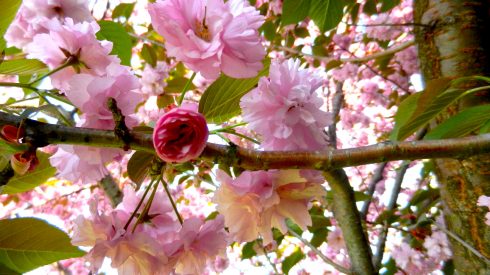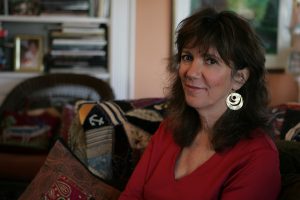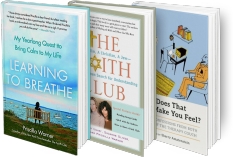
What Grief Taught Me About Joy
I’m no Elizabeth Kubler Ross.
But I do know a little bit about dying.
And joy.
Because everybody becomes an expert on death sooner or later.
And that’s why we have to cultivate joy however and whenever we can.
My father died at the age of 60, following a painful battle with colon cancer. When I returned to my apartment building after his funeral, I bumped into my superintendent, who offered his condolences.
“I didn’t expect to lose my father when I was thirty-five,” I said, fighting back tears.
“I lost my father when I was seventeen,” he told me.
But mourning isn’t a competition. No one wins a prize for good grieving. Losing a loved one can take the form of a grueling marathon or a sudden, horribly-gone-wrong high dive. The road back to feeling grounded takes twists and turns that require strength, commitment, humility and grace.
Every loss and attempt to recover from that loss is an experience we have to go through on our own, at our own pace, no matter how old, accomplished, spiritually enlightened, or loved we are.
Loss is a wound that takes time to heal.
Sometimes the wound heals on its own. Sometimes a friend can say just the right thing to help. Sometimes professionals with specific expertise need to be consulted. Sometimes just a little bit of fresh air does the trick.
For me, reflective writing also works wonders.
In a relatively short period of time a few years ago, my father-in-law died suddenly, my mother “dropped her body” (her words) after battling Alzheimer’s for thirteen years, my friend died, and my sister-in-law went to sleep and never woke up.
Then our puppy was diagnosed with a rare form of cancer.
So I sat still for a long time.
Sometimes I didn’t even get out of bed.
I sat in silence at my kitchen table.
I walked around New York City with my grief.
I drove around the suburbs with my grief.
And sometimes I took it for a walk in the woods. Or along a beach.
I cried every day for three years, and then I started crying every other day.
Joan Halifax, a brilliant Buddhist teacher, writes about the mystery of death: Suddenly we’re thrust into uncharted territory. We leave behind everything familiar and move into the unknown. In Buddhist terms, we’re called into a realm of “unknowing” or “beginner’s mind.”
Seeing things as a “beginner” can be frightening.
So it took me a while to become an “intermediate” about facing death.
Although I’d been thinking about my own death unconsciously all my life.
I almost died when I was sixteen months old, and my parents used to tell me the story of that terrifying experience over and over again, amplifying the trauma that had been lodged inside me. The hundreds of panic attacks I experienced since the time I was a teenager were all related to that ordeal. The tracheotomy scar on my throat was a constant reminder of what I’d been through when I briefly stopped breathing due to a rare infection in my windpipe; death had been imprinted on me as a child. Literally.
But thanks to a psychotherapy called EMDR, I was able to process a lot of the fear that had been stored in my body and mind decades later. And then I was able to face death as somewhat of a spiritual challenge from the universe, sent to every single one of us by God, Yaweh, Buddha, or some other mysterious force.
“Awaken! Do not squander your life!” is the last line of a chant I heard in a zendo – a Buddhist meditation space – in Manhattan when I was researching my last book. Roshi Pat O’Hara, the Zen priest I met there, introduced me to the concept of Japanese death poems, which are written in order to contemplate life intently in the shadow of our inevitable fate. I wrote a death poem myself for my last book.
Roshi also spoke to me about the poetic significance of cherry blossoms, as their brief life on earth mirrors the fragility of our own lives. And now I wait every spring for the three cherry trees in our front yard to come into bloom. As soon as they do I make sure to spend time lying on the grass underneath their wide branches, watching the ripest blossoms fall down from the trees, slowly and gracefully.
To their death.
The lives of cherry blossoms are brief and gorgeous.
They’re a reminder of how much we have to treasure and appreciate our own blooming season.
*
I was profiled in The New York Times several years ago for a book I co-authored called The Faith Club, and when a photographer emailed me to confirm a date and time for a photo shoot, I knew that his name sounded familiar.
Then when Dith Pran walked through the front door a week later, I realized that I knew his whole life story.
Or at least an enormous part of it.
Dith was employed as a translator for The New York Times during the fall of Phnom Phen, and he was the subject of a spectacular film called The Killing Fields. When the journalists he was working for were evacuated, Dith was not allowed to leave, so he spent the next four years in a forced labor camp, being tortured and nearly dying of starvation. The Khymer Rouge eventually murdered almost two million people, including Dith’s three brothers and one sister. But he managed to escape the camp, making the thirty mile journey to Siem Reap, then Thailand, where he was finally reunited with a NYT journalist, who brought him back to America. After learning that fifty members of his family had been slaughtered in the genocide, Dith became a photographer in New York, and a crusader for justice in Cambodia. And I’ve never been so humbled by someone’s presence as I was when he entered my home.
I treasure the lovely photographs that Dith took of me that day.

We spent an hour together and while we didn’t speak specifically about his experience, it was always in the room with us. When he died a few years later – of cancer – I remembered what he’d told me about death, describing the body as a house. “When it’s full of termites,” we leave,” he said, perhaps referencing his own house at the time.
I don’t remember what else we talked about. What I do remember most about Dith are the emails that he sent me a couple of weeks later, because of the way he ended each one.
I saved snippets of them for posterity:
Priscilla: good morning – how are you . It was very nice meeting and working with you . Today is very cold for me . Hope i will get the assignment indoor ….Happy friday …..Best, Pran
nice to hear from you …… Enjoy your Tuesday …Best, Pran
Hi from NJ shore .Am glad you like that pic . i like too … happy wednesday and happy spring and happy the last day of february…
Greetings from woodbridge , nj —how are you ? hope you are fine . Am glad you got the photos —happy monday…
*
I’ve marked thousands of days off on dozens of calendars without being especially mindful, but now I try to look at every one of them as a gift that I should have cherished.
A Happy Tuesday. Or Friday. Or Thursday…
It’s not like I’ve banished the concept of grief from my life; I take grief with me wherever I go now.
It’s in the back of my mind on the sunniest of spring days, when the birds are chirping, the sun is shining and hope is in the air.
It sits in the background of the beautiful life that I no longer take for granted.
I’ve learned to practice gratitude as an antidote to pain and sorrow.
I’ve learned that everyone has to figure out their own ways to integrate everything that human beings feel – in the course of a day, a minute or a lifetime.
And if we can acknowledge our mutual pain and suffering – along with our joy, laughter and mindful appreciation of life – grief can be our greatest teacher.
